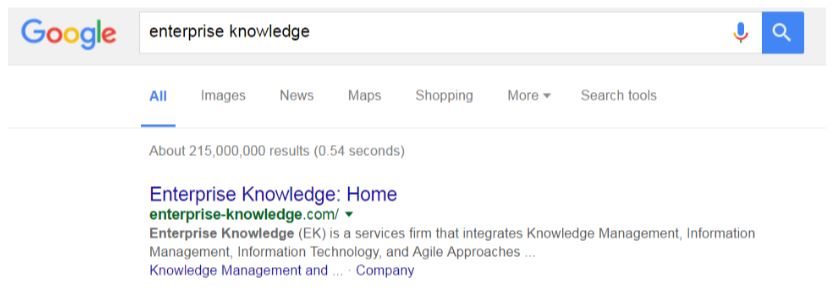The Internet (and likely your spam box) abounds with blog posts about how to improve your website’s SEO. There are an overwhelming number of tips and tricks to get your page at the top of that Google search results list. Unless you’re committed to SEO taking up a huge percentage of the time you have to dedicate to content strategy, you should focus in on a few, simple rules that you can actually remember. Here are three, actionable steps you can take to improve your SEO.
SEO Basics
We all know what most Google search results look like. While there are exceptions, most pages display three key elements in the list: title, description, and link. If you know how to optimize those three pieces of information you’re sending to Google, you’ve got a great start down the path towards improved SEO.

Step 1: Create an accurate, unique title
The title in your search results is simply the title of your page so it’s very easy to find and edit. Since it’s big, bold, and highly visible in the search results list you want to pay the most attention to this value. Titles should be accurate – meaning they should clearly and concisely communicate the topic of the page. Do not choose a metaphorical page title – save the poetry for another time! The page title should also be unique – don’t use the same page title more than once on your website.
Step 2: Write an accurate short description with the user in mind
The snippet is what Google calls the short description of the page which displays in the search results list. It gives the user some more clues about whether the content on the page matches what he or she is looking for. Snippets are a bit of a mystery since there is not usually a “snippet” field in your content management system. Without a little extra work there’s not a way for you to communicate to Google what should display in this space.
When you’re creating the content for your website, you can add content within description meta tags (your knowledge management professional or developer can tell you how to do this). When you edit the content within description meta tags you’re telling Google that you’d like them to use this content for the snippet. This is the best we can do because Google doesn’t always do what we want.
Once you figure out how to edit the content in the description meta tags, here are a few tips:
- Accurately summarize the content on the page. Just like writing the page title – this is not the time to get flowery and poetic.
- Imagine the user – Picture yourself scanning through page after page of Google search results. What clear, concise description would capture your attention and make you want to read more?
- Use unique descriptions for each page of your website. If you’re using the same (or very similar) descriptions for every page, users and Google have a hard time telling which page on your site is most relevant to their interests.
Step 3: Create URLs with Meaning
Since Google is also looking at your URL for information about what’s on your site, avoid URL structures that do not convey information like URLs with ID numbers in them or URLs with unrecognizable parameters. If you’re not a developer, you can still make content decisions which will improve the URLs on your site. One of the simplest is to create meaningful filenames for the documents on your website. The URL will often contain the entire structure of your document or sitemap as is shown in this example from our website. Note that even if the page title and description were not visible, you’d still have a relatively clear picture of what you’d find when you click that link. https://enterprise-knowledge.com/knowledge-base/?fwp_topic=taxonomy-design&fwp_article_type=video
Creating meaningful names for categories and files on your site is especially important when implementing an enterprise knowledge management system where the file tree can get unwieldy very quickly.
If you’re serious about improving SEO, learn the rules
These three steps will start you down the path to improved Search Engine Optimization, but there is a lot more to learn. This short video with the head of Google’s webspam team gives some more information about the three elements of the search result discussed above.
The reality is, however, you could spend an entire career learning the craft of Search Engine Optimization. Don’t be overwhelmed! Apply these three simple steps to improve your SEO and contact EK’s content and brand strategy consultants for help.
